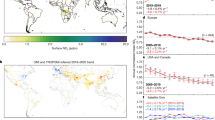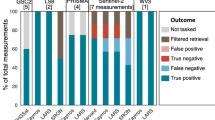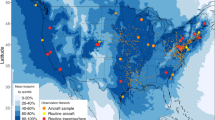Abstract
Sulfur dioxide is designated a criteria air contaminant (or equivalent) by virtually all developed nations. When released into the atmosphere, sulfur dioxide forms sulfuric acid and fine particulate matter, secondary pollutants1 that have significant adverse effects on human health2,3,4,5, the environment1 and the economy5. The conventional, bottom-up emissions inventories used to assess impacts, however, are often incomplete or outdated, particularly for developing nations that lack comprehensive emission reporting requirements and infrastructure. Here we present a satellite-based, global emission inventory for SO2 that is derived through a simultaneous detection, mapping and emission-quantifying procedure, and thereby independent of conventional information sources. We find that of the 500 or so large sources in our inventory, nearly 40 are not captured in leading conventional inventories. These missing sources are scattered throughout the developing world—over a third are clustered around the Persian Gulf—and add up to 7 to 14 Tg of SO2 yr−1, or roughly 6–12% of the global anthropogenic source. Our estimates of national total emissions are generally in line with conventional numbers, but for some regions, and for SO2 emissions from volcanoes, discrepancies can be as large as a factor of three or more. We anticipate that our inventory will help eliminate gaps in bottom-up inventories, independent of geopolitical borders and source types.
This is a preview of subscription content, access via your institution
Access options
Subscribe to this journal
Receive 12 print issues and online access
$259.00 per year
only $21.58 per issue
Buy this article
- Purchase on Springer Link
- Instant access to full article PDF
Prices may be subject to local taxes which are calculated during checkout



Similar content being viewed by others
References
Seinfeld, J. H. & Pandis, S. N. Atmospheric Chemistry and Physics 2nd edn (Wiley, 2006).
Lelieveld, J. et al. The contribution of outdoor air pollution sources to premature mortality on a global scale. Nature 525, 367–371 (2015).
Lim, S. S. et al. A comparative risk assessment of burden of disease and injury attributable to 67 risk factors and risk factor clusters in 21 regions, 1990–2010: a systematic analysis for the Global Burden of Disease Study 2010. Lancet 380, 2224–2260 (2012); correction 381, 628 (2013).
Prüss-Ustün, A. et al. Preventing Disease through Healthy Environments: A Global Assessment of the Burden of Disease from Environmental Risks (World Health Organization, 2016); http://www.who.int/quantifying_ehimpacts/publications/preventing-disease/en
The Cost of Air Pollution: Health Impacts of Road Transport (OECD, 2014).
Lamsal, L. N. et al. Application of satellite observations for timely updates to global anthropogenic NOx emission inventories. Geophys. Res. Lett. 38, L05810 (2011).
Martin, R. V. Satellite remote sensing of surface air quality. Atmos. Environ. 42, 7823–7843 (2008).
Streets, D. G. et al. Emissions estimation from satellite retrievals: a review of current capability. Atmos. Environ. 77, 1011–1042 (2013).
Beirle, S. et al. Megacity emissions and lifetimes of nitrogen oxides probed from space. Science 333, 1737–1739 (2011).
Fioletov, V. E., McLinden, C. A., Krotkov, N. & Li, C. Lifetimes and emissions of SO2 from point sources estimated from OMI. Geophys. Res. Lett. 42, 1969–1976 (2015).
de Foy, B. et al. Estimates of power plant NOx emissions and lifetimes from OMI NO2 satellite retrievals. Atmos. Environ. 116, 1–11 (2015).
Li, C., Joiner, J., Krotkov, N. A. & Bhartia, P. K. A fast and sensitive new satellite SO2 retrieval algorithm based on principal component analysis: application to the ozone monitoring instrument. Geophys. Res. Lett. 40, 6314–6318 (2013).
Levelt, P. F. et al. The ozone monitoring instrument. IEEE Trans. Geosci. Remote 44, 1093–1101 (2006).
Dee, D. P. et al. The ERA-Interim reanalysis: configuration and performance of the data assimilation system. Q. J. R. Meteorol. Soc. 137, 553–597 (2011).
Pommier, M., McLinden, C. A. & Deeter, M. Relative changes in CO emissions over megacities based on observations from space. Geophys. Res. Lett. 40, 3766–3771 (2013).
Janssens-Maenhout, G. et al. HTAP_v2: a mosaic of regional and global emission gridmaps for 2008 and 2010 to study hemispheric transport of air pollution. Atmos. Chem. Phys. 15, 11411–11432 (2015).
Granier, C. et al. Evolution of anthropogenic and biomass burning emissions of air pollutants at global and regional scales during the 1980–2010 period. Climatic Change 109, 163–190 (2011).
Janssens-Maenhout, G., Pagliari, V., Guizzardi, D. & Muntean, M. Global Emission Inventories in the Emission Database for Global Atmospheric Research (EDGAR) Manual (I): Gridding: EDGAR Emissions Distribution on Global Gridmaps JRC Report EUR 25785 EN (2013); http://dx.doi.org/10.2788/81454
Night Lights 2012—The Black Marble (NASA Earth Observatory, 2012); http://earthobservatory.nasa.gov/IOTD/view.php?id=79803
Davis, C. B. et al. Enipedia & Energy Industry Group, Faculty of Technology, Policy and Management (TU Delft, 2015); http://enipedia.tudelft.nl
Bucsela, E. J. et al. A new stratospheric and tropospheric NO2 retrieval algorithm for nadir-viewing satellite instruments: applications to OMI. Atmos. Meas. Tech. 6, 2607–2626 (2013).
Reuter, M. et al. Decreasing emissions of NOx relative to CO2 in East Asia inferred from satellite observations. Nature Geosci. 7, 792–795 (2013).
Oda, T. & Maksyutov, S. A very high-resolution (1 km × 1 km) global fossil fuel CO2 emission inventory derived using a point source database and satellite observations of nighttime lights. Atmos. Chem. Phys. 11, 543–556 (2011).
Zhao, Y., Zhang, J. & Nielse, C. P. The effects of energy paths and emission controls and standards on future trends in China’s emissions of primary air pollutants. Atmos. Chem. Phys. 14, 8849–8868 (2014).
Klimont, Z., Smith, S. J. & Cofala, J. The last decade of global anthropogenic sulfur dioxide: 2000–2011 emissions. Environ. Res. Lett. 8, 014003 (2013).
Sparks, R. S. J., Biggs, J. & Neuberg, J. W. Monitoring volcanoes. Science 335, 1310–1311 (2012).
Diehl, T. et al. Anthropogenic, biomass burning, and volcanic emissions of black carbon, organic carbon, and SO2 from 1980 to 2010 for hindcast model experiments. Atmos. Chem. Phys. Discuss. 12, 24895–24954 (2012).
Keller, C. A. et al. HEMCO v1.0: a versatile, ESMF-compliant component for calculating emissions in atmospheric models. Geosci. Model Dev. 7, 1409–1417 (2014).
Global Sources of Local Pollution: An Assessment of Long-Range Transport of Key Air Pollutants to and from the United States (National Academies, 2010).
Chance, K. et al. in Proc. SPIE 8866, Earth Observing Systems XVIII (eds Butler, J. J., Xiong, X. & Gu, X.) (SPIE, 2013).
Krotkov, N. A. et al. Aura OMI observations of regional SO2 and NO2 pollution changes from 2005 to 2015. Atmos. Chem. Phys. 16, 4605–4629 (2016).
Background Information about the Row Anomaly in OMI (OMI, 2012); http://projects.knmi.nl/omi/research/product/rowanomaly-background.php
McLinden, C. A. et al. Improved satellite retrievals of NO2 and SO2 over the Canadian oil sands and comparisons with surface measurements. Atmos. Chem. Phys. 14, 3637–3656 (2014).
von Engeln, A. & Teixeira, J. A planetary boundary layer height climatology derived from ECMWF Re-analysis data. J. Clim. 26, 6575–6590 (2013).
Hsu, N. C. et al. Global and regional trends of aerosol optical depth over land and ocean using SeaWiFS measurements from 1997 to 2010. Atmos. Chem. Phys. 12, 8037–8053 (2012).
Halmer, M. M. et al. The annual volcanic gas input into the atmosphere, in particular into the stratosphere: a global data set for the past 100 years. J. Volcanol. Geotherm. Res. 115, 511–528 (2002).
Stuefer, M. et al. Inclusion of ash and SO2 emissions from volcanic eruptions in WRF-Chem: development and some applications. Geosci. Model Dev. 6, 457–468 (2013).
Acknowledgements
R.V.M. was supported by Environment and Climate Change Canada. N.K., C.L. and J.J. acknowledge NASA funding through the Aura science team programme for OMI SO2 product development and analysis. The Dutch–Finnish-built OMI instrument is part of the NASA’s EOS Aura satellite payload. The OMI project is managed by KNMI and the Netherlands Space Office (NSO). The authors acknowledge ECMWF for the provision of their ERA-interim reanalysis data. C.A.M. thanks H. Morrison for commenting on earlier versions of the manuscript.
Author information
Authors and Affiliations
Contributions
C.A.M., V.F. and M.W.S. planned the research and developed the algorithm, C.A.M. and V.F. performed the computations and analysis, N.K., C.L. and J.J. provided the satellite data, C.A.M. wrote the paper, and all authors discussed the results and commented on the manuscript.
Corresponding author
Ethics declarations
Competing interests
The authors declare no competing financial interests.
Supplementary information
Supplementary Information
Supplementary Information (PDF 2621 kb)
Supplementary Information
Supplementary Information (XLSX 36 kb)
Supplementary Information
Supplementary Information (ZIP 187 kb)
Supplementary Information
Supplementary Information (ZIP 7465 kb)
Rights and permissions
About this article
Cite this article
McLinden, C., Fioletov, V., Shephard, M. et al. Space-based detection of missing sulfur dioxide sources of global air pollution. Nature Geosci 9, 496–500 (2016). https://doi.org/10.1038/ngeo2724
Received:
Accepted:
Published:
Issue Date:
DOI: https://doi.org/10.1038/ngeo2724
This article is cited by
-
Absorption mechanism and thermodynamics of SO2 using pH-buffered ionic liquid aqueous solution
International Journal of Environmental Science and Technology (2024)
-
Propane gas-sensing properties of pure and Pd-doped tin oxide nanostructures
Journal of Materials Science: Materials in Electronics (2023)
-
First Chinese ultraviolet–visible hyperspectral satellite instrument implicating global air quality during the COVID-19 pandemic in early 2020
Light: Science & Applications (2022)
-
Ethylene industrial emitters seen from space
Nature Communications (2022)
-
Severe atmospheric pollution in the Middle East is attributable to anthropogenic sources
Communications Earth & Environment (2022)



